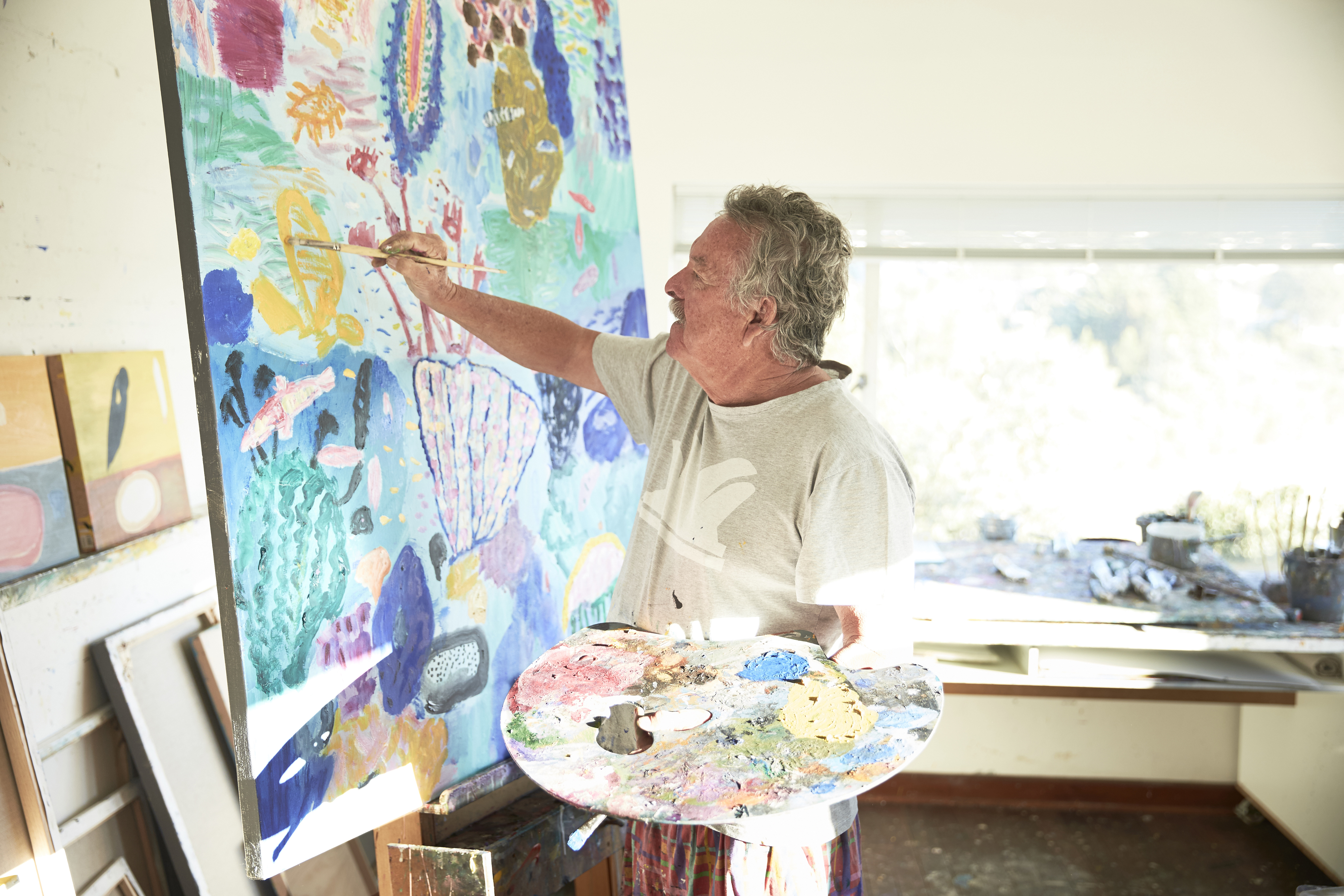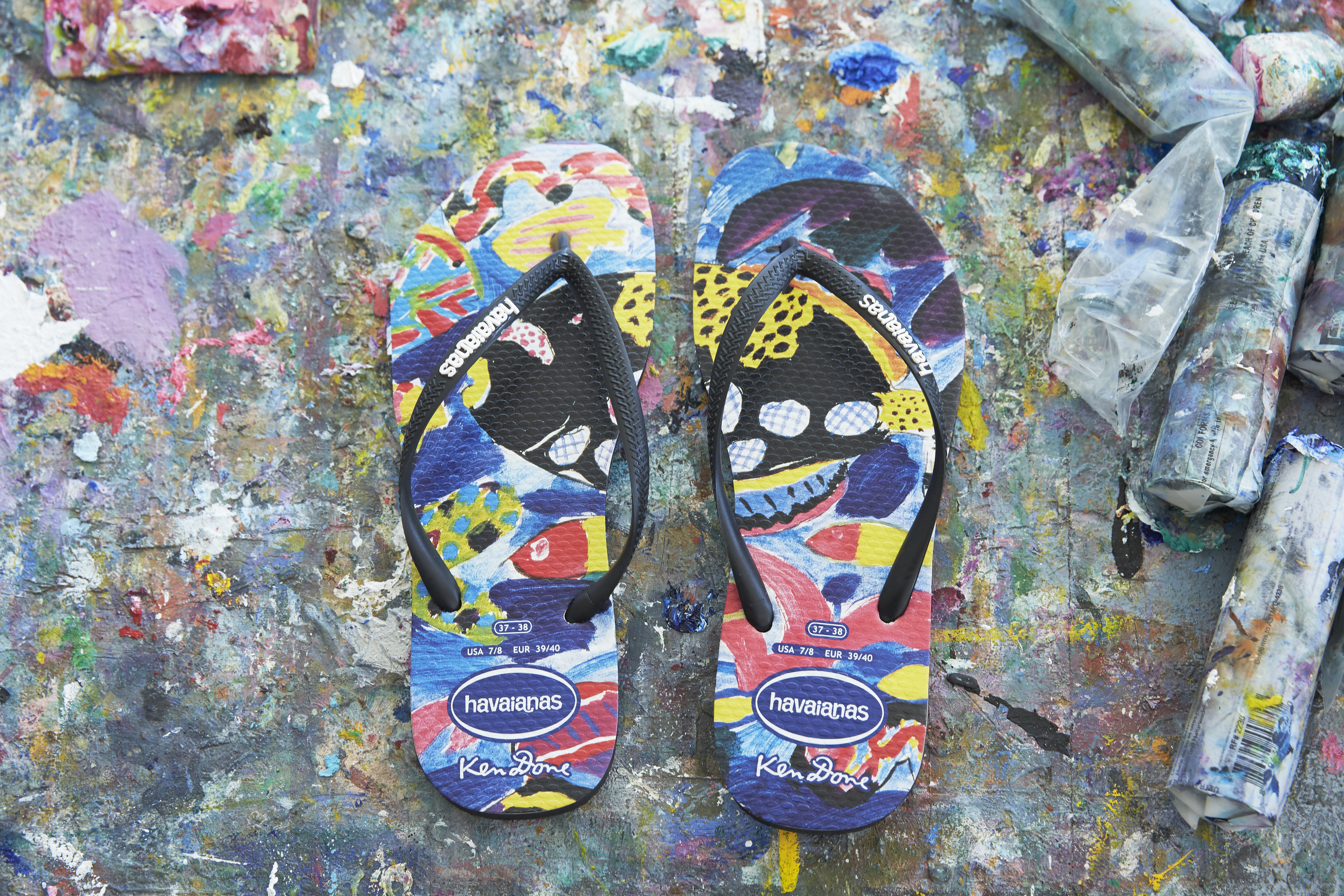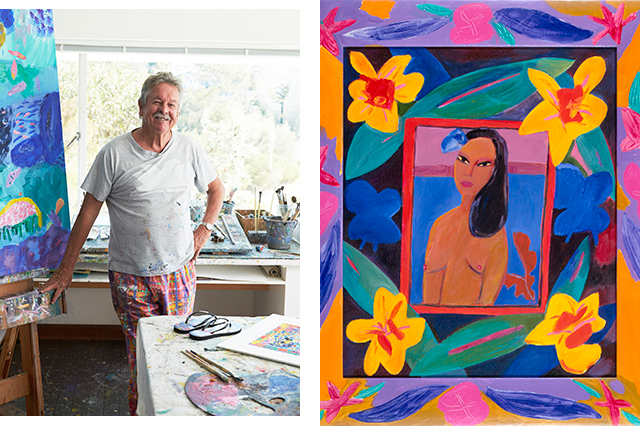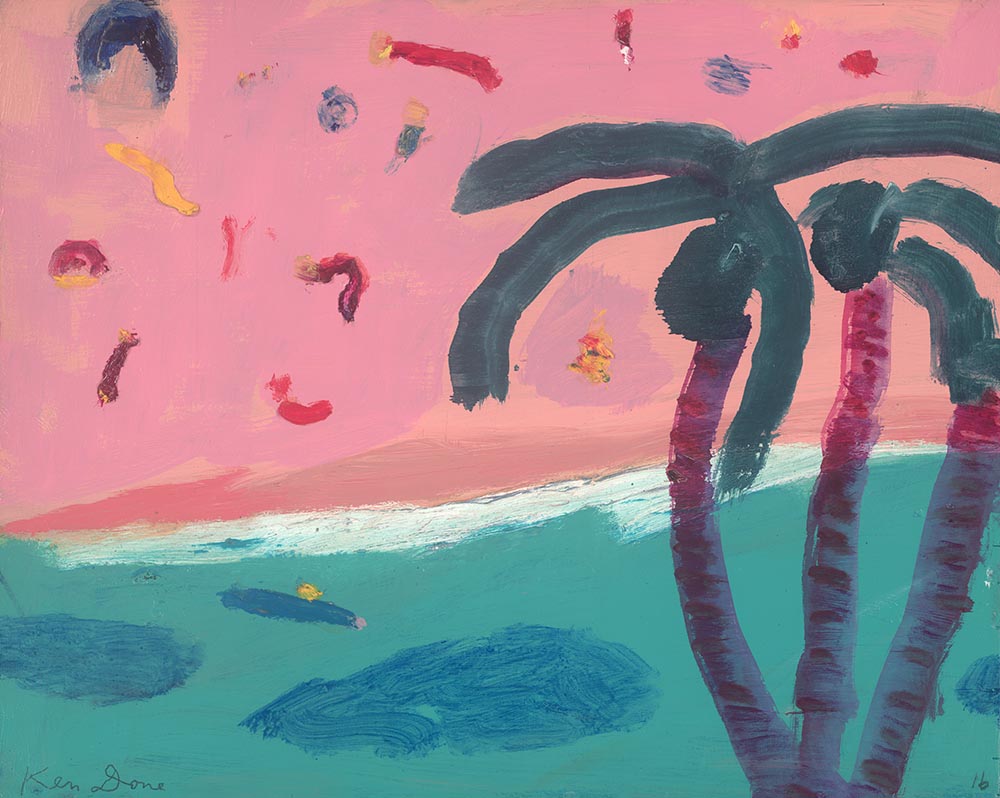
In an honest conversation, iconic Australian artist Ken Done talks to Buro Culture maker Noelle Faulkner about the business of art, time and what keeps him going
Recently, that era has come back in conversation, thanks to a rise in Australiana-redux; take bands like Client Liaison and their pop-culture-heavy videos and designers like Romance Was Born and Emma Mulholland, all who carry a heavy Australia-circa-Bicentennial flair in approach. Without a doubt, the work of Ken Done sits at the centre of this mood, as an icon that has endured.

‘Downstairs at the cabin’ 1984, Oil on canvas, 65 x 80cm
This summer, the 76-year-old has collaborated with another Aussie icon: the thong, the flip-flop, the plugger; lending one of this most recognisable works form 1984, the Great Barrier Reef Garden, to Brazilian brand Havaianas for a limited edition run of Ken Done thongs.
As the shoes hit stores, I sat down with the artist in his Sydney studio, who, as you can imagine, is as delightful and full of joy, passion and many, many stories (this is a heavily, heavily chopped down transcript, BTW). Iconography aside and whether you love his work or not, it seems we all need a bit of colourful optimism in our lives right now... even if it's just on our feet.

Let's start from the beginning; most people might be surprised to learn that you were a bit of a late bloomer to the art world. You famously worked as an advertising art director, can you remember what made you take a jump from the land of company cards to art?
Yes, well, I went to art school when I was 14 and a half, but I also wanted to travel. I worked in New York and London, went to Japan and Mexico. I really liked the advertising business and I was good at it. I had great accounts, I won the Cannes Gold Lion for best cinema commercials in 1968, (I was the art director), I had the Bacardi account, which would take you various places in the world as you were making films for Bacardi. I had a swimwear account so we'd often be in Portugal or Greece or somewhere shooting.
So yes, I liked the business, but I didn't want to do it forever. I got to the ripe old age of 35 and I realised no, I didn't want to spend any more time solving other people's problems. I wanted to be a painter. I think I was 35. I was the creative director of J. Walter Thompson. I resigned, and then I worked towards my first exhibition when I was 40. Which was only last year [laughs with a wink] no, I wish it was though... that's about 60 exhibitions ago, I suppose. [laughs again]

Right: ‘Model in a painted frame’ 1989, oil on board, 54 x 44cm
That's something many people struggle with in their job. That idea of freedom vs business Can you recall the moment of "I'm over it"?
Strangely enough, I was thinking about it the other day. Look, there's no kind of one ball out of the sky, although Judy [his wife] and I were on holidays in Vanuatu and it was on a Sunday. We were flying back Sunday night, and I happened to be sitting on the beach with Peter Brock, the racing driver.
We were sitting there on the beach and he was talking to me. I obviously knew who he was. He was talking to me about the passion that he had for racing driving, and I realised I didn't have a passion for advertising. I had a passion for art, and that if you're going to be any good at it, you had to devote your life to it. We flew back to Sydney and I walked in a Monday morning and resigned. That was it!
Was that terrifying?
People ask me that question, but it wasn't terrifying at the time, but I also had a child, I had a house in Mosman, I had a big mortgage... I was making lots of money but I didn't want to do it anymore and there wasn't a minute to waste. So what I had to work at is to see whether I could support us by what I could do with my hands. The first things that I did is that I made some very disciplined drawings of some shells and sell them to print shops. Really what I was doing is repeating the singular effort. I'd be making one drawing, reproducing it, seeking an audience - because you can't wait until a couple of days before you drop off the twig for people to start to pay you a lot of money for paintings! It's a very, very difficult business, very difficult.

‘Sydney night’ 1984, oil crayon and ink on paper, 70 x 80cm
I also made a Sydney Harbour T-shirt at the time when there was nothing that you could buy in Sydney that said "Sydney is a very sophisticated place". I'd already been to New York. I'd been to Acapulco. I'd been to Portofino - you know, you could buy a nice blue and white T-shirt and be in Acapulco. In those days, there wasn't much that you could buy that told you what a wonderful place Sydney was, so that started to rise. Then you see that rising and then you think, "Well, we need to have a shop."
I had the first exhibition, and then a few months later I opened my first gallery because I have always thought there's no reason why an artist shouldn't have his own gallery. No reason why a chef shouldn't own a restaurant. No reason why a singer shouldn't own a record company. No reason why a film director shouldn't own his film company. I've had my own gallery since then which is about 30, 40, 20, 30, almost 40 years. Almost 40 years. How can that be true? [laughs] I'm only 42?! I must have been a baby when I opened! [laughs again] I think I was just 30 and thought "Look this is not right." Then at the ripe old age of 35 you stop and you go and do something else. Who knows? I'm 76 now. Maybe when I'm 80, I might stop and become a brain surgeon. Or a piano player! Or just a really old man. [laughs]

Your work is so evident of the Australian attitude and way of life. There is so much joy of and a real sense of freedom about it.
I hope it represents the good things about Australia. 90% of the time, I would choose to make paintings about joy. Things to give you pleasure every time, because I think when you see Syria on television at night or you see that little boy in the back of the ambulance, covered in all the dust, or you see suicide bombers and all that while you're sitting there having dinner -well, I think that art should be more about pleasure.
It should give you pleasure over time. It's like a relationship. You might see a boy that you like very much and you might feel strong but you're not going to give him everything on the first day. It's like seeing a big painting. You might like it but if it's good, it's got to last over time.
There's a real cultural cringe around the time in Australia when your work started to take off that has shifted of late. I'm wondering what kind of pleasure does it give you to see people walking around wearing your paintings as part of their identity now?
I have seen a shift. But yeah, it's always flattering. It's always nice and look, I think the thing is with me, I was 40 before my first exhibition so I don't take all of this that seriously. It's not like the guy who suddenly is top of the charts when he's 19 and all he can do is wait to get into heroin and coke. I was 40. [laughs] I don't take it that seriously.

Beach and palms 2016, Oil and acrylic on wood panel, 40 x 50 cm
I'm particularly flattered by the fact that your generation really now understands what I do, because when you become... I hate the word, I hate it but you don't seek to be "famous", but when people first saw my work, they said, "Wow, this is fantastic! Oh, this is great! Oh, we love it! It's fabulous! Oh fuck me, it's everywhere! We don't like it. Oh no, we hate it ... Wait a minute that was quite good. Wow, we think that that's wonderful." It's like a big circle.
Is there something that you've always wanted to paint, but never have? Is there a Ken Done white whale?
Well, not really. I'd like to be better. Artists always want to be better at what they're doing, because it's a journey. As for the answer to there any person that I really want to paint? No, but there's people I would have liked to have talked to. There's a photo there on the wall [points across his studio] with me and Ray Charles, and I often make a painting on Ray Charles' birthday. I would have liked to talk more to him. Sidney Nolan, who I met twice, I would have liked to talk more to him too.
Do you ever get overwhelmed by colour?
Yes, I do sometimes! I remember I made a painting. I was in India and there were three or four women who walked past with saris that were just so bright and so beautiful and such intense colour, you just can't... Even this morning when I was walking up from the beach, we've got freesias growing in the garden. If you look really carefully at a freesia and you put your eye almost in it, and it's this wonderful pearl, mauve on the outside and then going into white, and then there's little bits of intense yellow and it smells so good, you can lose yourself in that. Lose yourself in a freesia! See there's another painting! Sometimes, the titles can come first, "Losing yourself in a freesia." I like that.

‘Ava’s reef’ 2016, oil on linen, 122 x 153cm
I look forward to that painting.
Oh,I look forward to drawing it!
Can you describe that desire to put paint on a canvas and draw it?
No, I don't think I can. I think it's just something that I do. I think it's just something that I do. It's got a great deal to do with passion. It's got a certain amount to do with sex because it's the same kind of drive. When you get to my age and if you've had prostate cancer, which I have had but I'm still here, sometimes I think that it's the sexual drive is going into the paintings, but it's also about joy. It's about love. It's about wanting to do something beautiful. It's like when you compose a sentence and you put some words together, and sometimes it can be like poetry. To put a word beside another word tells you something about both words.
Well I can understand that. Do you like poetry?
Oh yes, I read a series of poems the other day. A bit longer than haiku, because I had made some paintings in that haiku, especially one that says, "I would learn of their dreams in flowers but butterflies have no voice." It's about the fact that butterflies live for such a brief period of time. All that they would understand is being in the beauty of flowers, so therefore if a butterfly slept and had a dream, that's what it would be about. Butterfly dreams. That's such a beautiful thought.
Does a butterfly have time to dream?!
Who knows? There's another Japanese haiku that says, "Don't waste time travelling along with me, butterfly." Which again is something about the relationship between a human being and the butterfly, and the brief period of time that the butterfly has.

Right: (clockwise from top) Sammy, Spot, Indi and Bex, 2016, all acrylic on linen, 100 x 80cm
How do you keep making?
I don't know. I think if I was a musician, I'd just say, "Well, I sit down at the piano and I play." For a painter, you walk into the studio and you just start to work. Usually, I'm working on three or four things at once because if I can't solve one, then I move to the other. It's quite a lonely business. What you do have to learn is to spend long periods of time on your own. That's why I think in the end a lot of artists do go a bit crackers because there's no group activity.
In the world of Ken Done, above all, what is worth pursuing?
Gee, that's a good question. On a personal level, because you're always painting I think for yourself, it's to get better at it. Now that's very hard because only you can define what's better. On the other side, being a good father and a good grandfather. My littlest grandson, is just learning to speak, calls me Fundad, not Granddad, Fundad. That's good. I like that. I want him to call me Fundad when he's 18.
Well, thank you, Fundad. I look forward to hearing about him introducing you as "Fundad" at his wedding...
"Ladies and gentlemen, Fundad!"
Ken Done x Havianas is available now from havaianasaustralia.com.au
A selection of Ken Done's work is currently in the Popular Pet Show at The National Portrait Gallery (until March 13), portrait.gov.au/exhibitions/the-popular-pet-show-2016
Follow Noelle:
Website: noellefaulkner.com
Instagram: @noelleflamingo
Twitter: @noelleflamingo